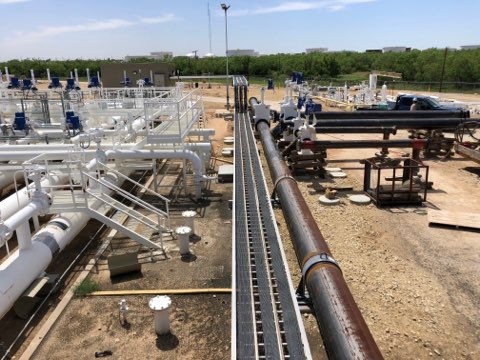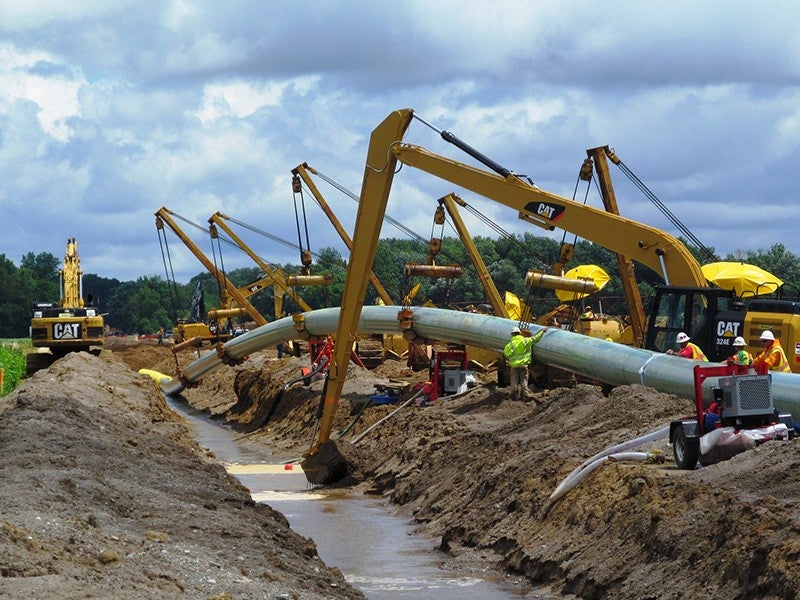Midland pipeline construction company: How design choices affect pipeline integrity
Comprehending the Key Features of Pipeline Services and Their Influence On Efficiency
Pipeline solutions play a necessary role in numerous markets, affecting functional efficiency noticeably. Trick attributes, such as sophisticated monitoring technologies and upkeep strategies, are important for reducing downtime. Additionally, regulative conformity assurances security and environmental management. The interplay between design, infrastructure, and economic factors can complicate these processes. Understanding how these elements effect overall performance raises essential questions about ideal methods and future growths in the field.
The Role of Technology in Pipeline Tracking
As improvements in innovation proceed to progress, the significance of reliable pipe tracking has actually come to be significantly evident. Modern pipeline systems depend on advanced tracking tools that improve functional efficiency and safety and security. Technologies such as real-time data analytics, sensing units, and drones supply drivers with prompt insights into pipe conditions, allowing them to discover leaks, rust, and various other potential problems prior to they intensify into substantial issues.
The assimilation of Internet of Things (IoT) gadgets has actually changed traditional surveillance techniques, permitting for continual monitoring and automated coverage. This proactive approach not just decreases risks however likewise enhances maintenance timetables and resource allotment. Furthermore, advanced software program systems assist in information visualization and analysis, empowering decision-makers to react promptly to abnormalities. Collectively, these technical advancements not just improve pipe integrity yet likewise foster environmental stewardship by reducing the prospective effect of leakages and spills.
Upkeep Approaches for Boosted Performance
Effective upkeep approaches are important for maximizing pipe efficiency. Applying predictive upkeep strategies, adhering to regular assessment protocols, and creating robust emergency response plans can greatly enhance operational reliability. These techniques not only reduce downtime yet additionally add to the total safety and integrity of pipe systems.
Anticipating Upkeep Strategies
Anticipating upkeep methods are increasingly recognized for their ability to enhance functional effectiveness in pipeline solutions. By leveraging information analytics and keeping an eye on innovations, these techniques allow drivers to anticipate tools failures prior to they occur. This positive approach decreases unintended downtime, decreases upkeep prices, and expands the life-span of vital properties. Sensors and IoT tools play a critical duty in gathering real-time data, permitting for the analysis of equipment wellness and performance fads. Artificial intelligence algorithms evaluate this data to recognize patterns and anticipate prospective problems. As a result, pipe operators can schedule upkeep tasks during non-peak times, enhancing source appropriation and making certain continual procedure. Eventually, the adoption of predictive maintenance fosters a more reliable and effective pipeline infrastructure.

Regular Evaluation Protocols
Regular evaluation procedures function as a cornerstone of upkeep methods targeted at boosting efficiency in pipeline procedures - Creek Pipe local contractor. These procedures involve methodical analyses of pipe stability, concentrating on spotting possible problems prior to they rise. Routine evaluations normally consist of visual evaluations, leak detection modern technologies, and pressure monitoring to guarantee peak efficiency. By sticking to established routines, operators can recognize rust, product wear, or obstruction, therefore decreasing downtime and repair prices. Furthermore, data collected throughout examinations can inform predictive maintenance initiatives, enabling a proactive strategy to pipeline management. Inevitably, regular examinations not only prolong the lifespan of pipeline infrastructure however likewise add to safer and more reputable transportation of resources, enhancing total operational performance
Emergency Situation Feedback Planning
Emergency response planning is important for maintaining efficiency in pipe operations, making sure that operators are prepared to deal with unexpected cases promptly and effectively. A well-structured emergency reaction plan consists of clear protocols, designated roles, and interaction techniques to mitigate risks related to pipeline failings. Regular drills and training boost group readiness and familiarize personnel with emergency procedures. Furthermore, having easily offered resources, such as spill control devices and emergency situation call listings, can greatly lower action times. By integrating real-time surveillance technologies, drivers can rapidly determine and respond to concerns, decreasing environmental effect and operational downtime. Eventually, a thorough emergency situation action strategy not just safeguards properties and employees yet also enhances the overall efficiency of pipe services.
Regulatory Conformity and Safety Standards
Regulative compliance and security criteria play a crucial role in the pipeline solutions sector. Pipeline services Midland Texas. Sticking to industry guidelines ensures that companies apply reliable safety and security protocols and risk monitoring strategies. This dedication not only shields employees and the setting however also improves total operational efficiency
Compliance With Sector Rules
Compliance with sector policies is necessary for guaranteeing the safety and effectiveness of pipeline procedures. Regulatory frameworks, such as those established by the Epa (EPA) and the Pipeline and Hazardous Materials Safety And Security Administration (PHMSA), set strict standards that operators need to follow. These guidelines cover various aspects, including pipeline style, building and construction, maintenance, and surveillance, assuring that systems operate safely and successfully. Non-compliance can lead to extreme fines, operational hold-ups, and environmental risks. By adhering to these guidelines, pipeline companies not only protect public safety and security and the setting but likewise improve their functional performance. Inevitably, governing compliance promotes trust amongst stakeholders, guaranteeing that pipe solutions can run effortlessly in a competitive landscape while satisfying lawful responsibilities.

Security Method Implementation
Efficient safety method implementation is an important part of pipeline operations, very closely linked to governing compliance and security criteria. Sticking to these protocols not just guarantees the defense of workers yet additionally safeguards the environment and facilities. A robust safety framework includes regular training, comprehensive evaluations, and the use of appropriate safety equipment. Organizations needs to stay alert in updating their protocols to reflect adjustments in regulations why not find out more and technical developments. Conformity with recognized security standards decreases the danger of crashes and boosts functional performance. Furthermore, a culture of safety cultivates staff member interaction and liability, adding to overall organizational success. Ultimately, effective safety and security method implementation is critical in preserving the stability of pipe solutions and achieving long-lasting sustainability in operations.
Risk Monitoring Methods
Executing durable threat monitoring strategies is important for ensuring that pipeline procedures follow governing needs and safety and security criteria. Organizations needs to determine possible risks and assess dangers associated with pipe activities. This includes carrying out complete assessments, utilizing sophisticated monitoring modern technologies, and preserving compliance with sector laws. Regular training for employees on security methods enhances situational understanding and prepares teams to react effectively to emergencies. Furthermore, establishing backup strategies and carrying out drills can significantly reduce dangers. Collaborating with governing bodies ensures alignment with developing safety and security requirements. By focusing on threat management, pipeline solutions can boost operational effectiveness while guarding both the environment and public safety and security. Ultimately, an aggressive approach to take the chance of monitoring cultivates a culture of safety and security within the industry.
Pipeline Style and Facilities Considerations
Exactly how can the style and facilities of pipelines influence general operational effectiveness? The arrangement of pipelines plays an important role in identifying their effectiveness. Reliable style decreases rubbing losses, thus minimizing power consumption during liquid transportation. Aspects such as diameter, product option, and design directly impact flow go right here prices and maintenance needs.
In addition, tactical positioning of shutoffs and monitoring systems boosts operational control and security. Midland oilfield pipeline services. Facilities considerations, consisting of availability for maintenance and repair, significantly affect downtime and overall productivity
Integrating sophisticated modern technology for real-time monitoring facilitates prompt discovery of leaks or inefficiencies, ensuring quick actions to problems. The total architectural honesty, influenced by product sturdiness and environmental elements, additionally shapes lasting functional success. As a result, thoughtful layout and durable framework are crucial for making best use of pipeline effectiveness, ultimately contributing to the dependability and earnings of pipeline solutions.
Environmental Effect and Sustainability Practices
While the demand for pipeline services remains to expand, comprehending the ecological effect and taking on sustainability techniques has actually come to be significantly crucial. The construction and operation of pipelines can significantly influence communities, wild animals habitats, and water sources. To minimize these effects, firms are executing advanced modern technologies and practices focused on minimizing emissions, protecting against spills, and decreasing land interruption.
Sustainability efforts commonly include utilizing eco-friendly products, improving energy performance, and utilizing renewable resource resources to power procedures. In addition, business are progressively conducting complete environmental assessments before job initiation, making sure conformity with guidelines and stakeholder engagement.

Cost Administration and Economic Elements in Pipeline Services
As the pipeline industry grows, effective price monitoring and recognizing financial factors end up being important for keeping competition. Firms face different financial stress, including rising and fall material expenses, labor costs, and governing conformity fees. To browse these obstacles, pipeline service carriers must take on strategic economic preparation and budgeting techniques.
Purchasing modern technology can boost operational efficiency, eventually reducing costs in time. Furthermore, effective job administration guarantees that sources are allocated successfully, decreasing delays and unanticipated expenditures.

Market problems, such as need for energy and geopolitical elements, also affect financial practicality. Business should stay dexterous, readjusting their strategies in reaction to these external factors.
Often Asked Concerns
What Are the Different Types of Pipeline Provider Available?
Various kinds of pipeline services include transport, storage, maintenance, examination, and fixing. Each solution plays an essential role in guaranteeing the seamless activity of products, enhancing safety and security, and lessening functional disturbances throughout various fields.
How Commonly Should Pipeline Inspections Be Conducted?
Pipeline evaluations should be performed frequently, normally every one to 3 years, depending upon the type and problem of the pipeline. More constant evaluations may be required for older or high-risk pipelines to ensure safety and stability.
What Are the Key Causes of Pipeline Failures?
The main root causes of pipeline failures include corrosion, faulty construction, product flaws, outside damages, leaks, and operational errors. Each variable adds substantially to possible threats, highlighting the relevance of normal upkeep and surveillance for safety and security.
How Can Business Improve Pipeline Service Reliability?
Firms can improve pipeline service dependability by executing normal upkeep timetables, utilizing advanced tracking innovations, conducting thorough inspections, spending in worker training, and taking on proactive risk administration strategies to expect and reduce prospective failings.
What Duty Do Operators Play in Pipeline Providers?
Operators play an important role in pipeline services by making sure safe transportation, preserving devices, monitoring system honesty, collaborating maintenance, and reacting to emergencies. Their competence straight affects functional performance and lessens disturbances in solution distribution.